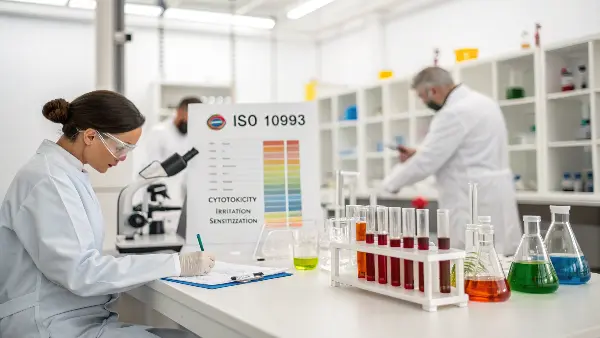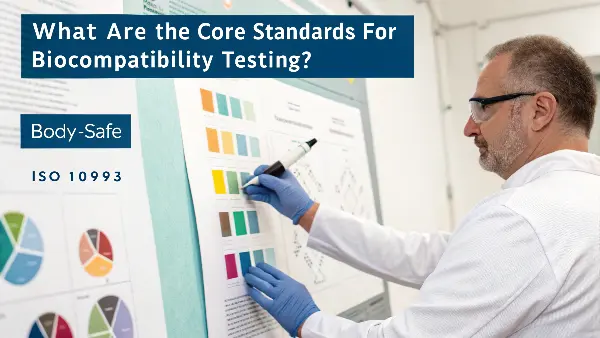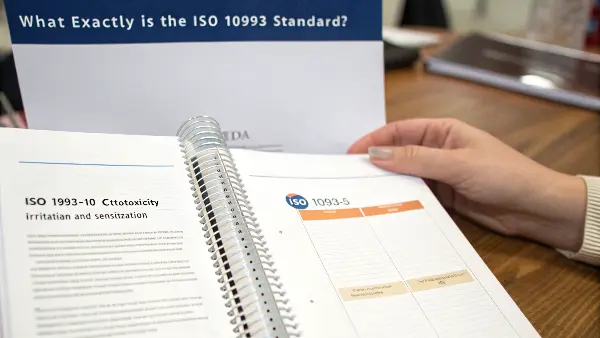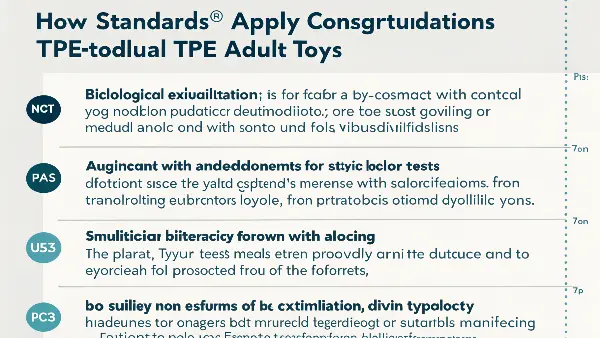Sourcing TPE adult toys brings safety worries. A bad material choice can harm customers and your brand’s reputation overnight. The key is adhering to strict biocompatibility testing standards. This ensures your products are safe, builds customer trust, and protects your business from serious risks.
The main standard for the biocompatibility testing of TPE adult products is ISO 10993. This set of protocols, designed for medical devices, evaluates how materials interact with the body. Key tests include cytotoxicity (cell toxicity), irritation, and sensitization (allergic reactions). Adhering to this standard ensures the TPE material is non-toxic, non-irritating, and safe for intimate contact, providing essential safety assurance for your customers.

These standards might sound complex, but they are the bedrock of product safety in our industry. As a brand owner or sourcing manager, you don’t need to be a scientist, but you do need to know what questions to ask your manufacturer. So, let’s break down what these standards really mean for your brand and your products. By the end, you’ll feel much more confident in your sourcing decisions and your ability to verify a supplier’s claims.
What Are the Core Standards for Biocompatibility Testing?
You see "body-safe" everywhere, but what does it really mean? Without a concrete standard, you’re just trusting a marketing claim, which is a huge risk for your business. True safety comes from following established, globally recognized testing protocols that provide verifiable proof of a material’s biocompatibility and quality.
The core standard for biocompatibility testing is the ISO 10993 series, officially titled "Biological evaluation of medical devices." While other regional standards exist, like USP Class VI in the United States, ISO 10993 is the global benchmark. It provides a risk-based framework to determine which tests are necessary based on the device’s contact type and duration with the body, ensuring a comprehensive safety evaluation.

Dive Deeper
When I first started in this industry, I assumed "biocompatible" meant a single, simple test. I quickly learned it’s a highly structured process. The reason ISO 10993 is the gold standard is because it’s not a one-size-fits-all checklist. It’s an intelligent framework that tailors the testing to the actual risk of the product. An external-use massager that only touches intact skin requires less rigorous testing than a toy designed for internal use that will be in contact with mucosal membranes. This risk-based approach is what makes the standard so robust and reliable.
The Risk-Based Approach
The standard first asks us to categorize a product based on two key factors:
- Nature of Body Contact: Is it a surface-contacting device (skin, mucosal membranes), an externally communicating device, or an implant device? Most adult toys fall into the surface-contacting category.
- Duration of Contact: How long will it be in contact with the body? This is broken down into Limited (≤ 24 hours), Prolonged (> 24 hours to 30 days), and Permanent (> 30 days).
Based on the answers, a matrix in the ISO 10993-1 document points to the exact biological effects that must be evaluated. For a typical TPE vibrator, this almost always points to what I call the "Big Three" tests.
Key Testing Categories: The "Big Three"
For most adult products we manufacture, the evaluation focuses on these three critical endpoints. We consider them non-negotiable for establishing baseline safety.
| Test Name | ISO Standard Part | What It Checks For | Why It Matters for TPE Toys |
|---|---|---|---|
| Cytotoxicity | ISO 10993-5 | Does the material release substances that are toxic to living cells? | This is the most fundamental safety test. If a material kills cells in a lab dish, it has no business being used in an intimate product. |
| Irritation | ISO 10993-10 | Will the material cause a localized inflammatory reaction (like redness or swelling) after single or repeated exposure? | This simulates real-world use. It ensures the toy won’t cause immediate discomfort or a rash on the skin or sensitive mucous membranes. |
| Sensitization | ISO 10993-10 | Will the material trigger an allergic reaction after repeated exposure? | This is crucial for long-term brand trust. An allergic reaction can develop over time, so this test helps ensure customers won’t suddenly have a bad experience. |
Asking a potential supplier, "Can you provide the test reports for cytotoxicity, irritation, and sensitization according to ISO 10993?" is how you move beyond marketing claims and start verifying true product safety.
What Exactly Is the ISO 10993 Standard?
You know ISO 10993 is important, but the details can be fuzzy. This ambiguity can leave you vulnerable to suppliers who might cut corners or provide incomplete information. You need absolute clarity to make informed sourcing decisions. Understanding the specific parts of this standard empowers you to demand the right documentation and protect your brand.
ISO 10993 is a series of international standards for the biological evaluation of medical devices. Part 1 outlines the general framework, while other parts specify the exact test methods. For adult toys, the most critical parts are ISO 10993-5 (cytotoxicity) and ISO 10993-10 (irritation and sensitization). These tests confirm that a material won’t poison cells or cause allergic reactions.

Dive Deeper
Think of ISO 10993 as a multi-volume encyclopedia of safety, not a single book. Each volume, or "Part," covers a specific aspect of biological testing. For someone sourcing adult products, you don’t need to memorize every part, but knowing the key ones is a massive advantage. It shows potential manufacturing partners that you are a serious, knowledgeable professional. We always have these reports on hand for our materials because we know our clients expect this level of diligence.
Breaking Down the Key Parts
When we validate a new TPE formulation, we focus on a core set of these standards. Here are the ones that come up most frequently in our work with clients launching new intimate products.
| ISO Part | Official Title (Simplified) | What It Means for Your Product |
|---|---|---|
| ISO 10993-1 | Evaluation and Testing Framework | This is the master guide. It helps us determine which of the other tests are necessary based on the toy’s design, materials, and intended use. |
| ISO 10993-5 | Tests for In Vitro Cytotoxicity | This part details the laboratory methods for testing if the TPE leaches any chemicals that are toxic to cells. A passing grade (typically Grade 2 or less) is a must. |
| ISO 10993-10 | Tests for Irritation and Skin Sensitization | This part provides the protocols for testing if the TPE causes redness (irritation) or an allergic response (sensitization). This is crucial for user comfort and safety. |
| ISO 10993-18 | Chemical Characterization of Materials | This is often a starting point. Before biological testing, we analyze the TPE to understand its chemical makeup and identify any potentially hazardous substances from the outset. |
I remember a situation where we evaluated a new, low-cost TPE from a potential supplier. It passed the cytotoxicity test, which was great. However, during the ISO 10993-10 sensitization test, it showed a borderline result. While some might have let it slide, we rejected the material immediately. That small detail on a test report saved our client from a potential product recall and protected their customers’ well-being. This is a perfect example of why you can’t just tick one box; you need the full picture that the ISO 10993 series provides.
How Do These Standards Apply Directly to TPE Adult Toys?
The theory is great, but how does this all apply to the TPE vibrator or dildo you’re about to order? It’s easy to get lost in standard numbers and forget the practical application. You need to connect the dots between the lab report and your actual product to ensure you’re truly covered and making a safe choice for your customers.
For TPE adult toys, these standards are applied by creating a "biological evaluation plan." This plan considers the toy’s intimate contact with mucosal membranes and skin, and its duration of use. Based on this, specific tests from ISO 10993 (usually cytotoxicity, irritation, and sensitization) are performed on the final, processed TPE material to confirm it is non-toxic and non-allergenic for its intended purpose.

Dive Deeper
Bringing a new TPE adult toy to market safely is a step-by-step process. At PrivyPlay, when a client comes to us with a new design, our conversation about safety protocols is just as important as the one about aesthetics and function. We don’t just manufacture a product; we build a complete safety profile for it, starting from the raw TPE pellets and ending with the finished, packaged good. This process turns the abstract standards into concrete, actionable steps.
Step 1: Chemical Characterization
Before we even think about biological tests, we often start with the chemistry. This aligns with ISO 10993-18. We need to know exactly what is in the TPE formulation. We analyze the material for known chemicals of concern like phthalates, heavy metals, latex, and other restricted substances. If a harmful chemical is present in the raw material, there’s no point in proceeding. This initial screening is a critical gatekeeper for quality and safety. It ensures we’re building your product on a pure and safe foundation.
Step 2: Categorizing the Device and Creating a Plan
Next, we formally categorize your product according to ISO 10993-1. A typical vibrator is classified as a "surface device" with "mucosal membrane contact" for a "limited duration" of use. This classification is vital because it dictates the testing plan. It tells us that, at a minimum, we must have passing reports for cytotoxicity, irritation, and sensitization. This isn’t just our company policy; it’s the global expectation for a device of this nature. This plan becomes our roadmap for safety verification.
Step 3: Performing the ‘Big Three’ Tests on the Final Material
This is the most crucial part. The tests aren’t performed on the raw TPE pellets. They are performed on samples taken from the actual, final product after it has gone through the full manufacturing process (molding, heating, cooling, etc.). Why? Because the manufacturing process itself can sometimes alter the material or introduce contaminants. Testing the final product is the only way to be 100% certain that the item your customer receives is safe. We then send these samples to a third-party, accredited laboratory to conduct the ISO 10993-5 (cytotoxicity) and ISO 10993-10 (irritation and sensitization) tests. A passing report from that lab is the final quality gate before we approve a material for mass production.
Conclusion
In short, ensuring the safety of TPE adult products is not about guesswork; it’s a systematic process defined by ISO 10993. This isn’t a suggestion but a requirement for any brand that values its customers and reputation. This is how we elevate pleasure by first empowering confidence in safety.
